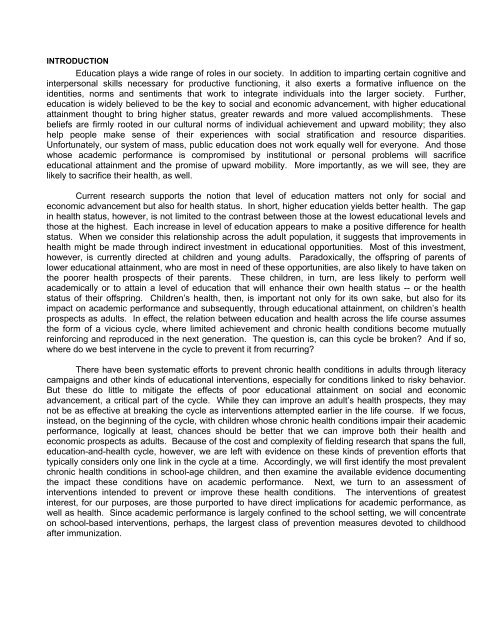COD E R E D
Download - Code Red: The Critical Condition of Health in Texas
Download - Code Red: The Critical Condition of Health in Texas
- No tags were found...
You also want an ePaper? Increase the reach of your titles
YUMPU automatically turns print PDFs into web optimized ePapers that Google loves.
INTRODUCTIONEducation plays a wide range of roles in our society. In addition to imparting certain cognitive andinterpersonal skills necessary for productive functioning, it also exerts a formative influence on theidentities, norms and sentiments that work to integrate individuals into the larger society. Further,education is widely believed to be the key to social and economic advancement, with higher educationalattainment thought to bring higher status, greater rewards and more valued accomplishments. Thesebeliefs are firmly rooted in our cultural norms of individual achievement and upward mobility; they alsohelp people make sense of their experiences with social stratification and resource disparities.Unfortunately, our system of mass, public education does not work equally well for everyone. And thosewhose academic performance is compromised by institutional or personal problems will sacrificeeducational attainment and the promise of upward mobility. More importantly, as we will see, they arelikely to sacrifice their health, as well.Current research supports the notion that level of education matters not only for social andeconomic advancement but also for health status. In short, higher education yields better health. The gapin health status, however, is not limited to the contrast between those at the lowest educational levels andthose at the highest. Each increase in level of education appears to make a positive difference for healthstatus. When we consider this relationship across the adult population, it suggests that improvements inhealth might be made through indirect investment in educational opportunities. Most of this investment,however, is currently directed at children and young adults. Paradoxically, the offspring of parents oflower educational attainment, who are most in need of these opportunities, are also likely to have taken onthe poorer health prospects of their parents. These children, in turn, are less likely to perform wellacademically or to attain a level of education that will enhance their own health status -- or the healthstatus of their offspring. Children’s health, then, is important not only for its own sake, but also for itsimpact on academic performance and subsequently, through educational attainment, on children’s healthprospects as adults. In effect, the relation between education and health across the life course assumesthe form of a vicious cycle, where limited achievement and chronic health conditions become mutuallyreinforcing and reproduced in the next generation. The question is, can this cycle be broken? And if so,where do we best intervene in the cycle to prevent it from recurring?There have been systematic efforts to prevent chronic health conditions in adults through literacycampaigns and other kinds of educational interventions, especially for conditions linked to risky behavior.But these do little to mitigate the effects of poor educational attainment on social and economicadvancement, a critical part of the cycle. While they can improve an adult’s health prospects, they maynot be as effective at breaking the cycle as interventions attempted earlier in the life course. If we focus,instead, on the beginning of the cycle, with children whose chronic health conditions impair their academicperformance, logically at least, chances should be better that we can improve both their health andeconomic prospects as adults. Because of the cost and complexity of fielding research that spans the full,education-and-health cycle, however, we are left with evidence on these kinds of prevention efforts thattypically considers only one link in the cycle at a time. Accordingly, we will first identify the most prevalentchronic health conditions in school-age children, and then examine the available evidence documentingthe impact these conditions have on academic performance. Next, we turn to an assessment ofinterventions intended to prevent or improve these health conditions. The interventions of greatestinterest, for our purposes, are those purported to have direct implications for academic performance, aswell as health. Since academic performance is largely confined to the school setting, we will concentrateon school-based interventions, perhaps, the largest class of prevention measures devoted to childhoodafter immunization.







